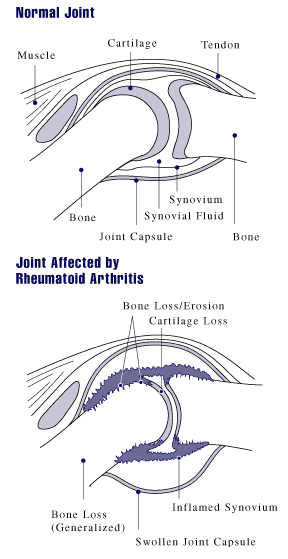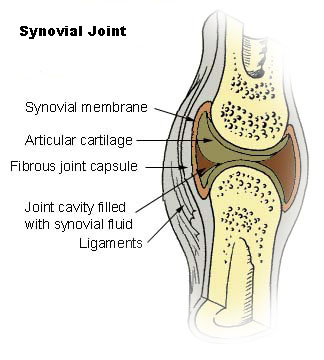|
Arthritis is a degenerative disease of the joint and often damages the cartilage cushion in the joints.by K. Molnar-Kimber, Ph.D. Rheumatoid arthritis can cause deformities of one or more joints. Many call it a degenerative disease of the joint. The 3 types of healthy joints include fibrous joints, cartilaginous joints and synovial joints. Rheumatoid arthritis usually inflames the joints of the foot, toes, hands, wrist, elbow, and knees. The hips, shoulders and neck may also become involved. Healthy joints in the foot, hands, wrist, elbow, knees, hips, shoulder, neck and back contain cartilage at the end of the bones.
This articular cartilage helps bones glide over one another when they’re healthy. Most of these joints are protected and nourished by a synovial-lined capsule as shown in this healthy knee joint. The Synovial membrane is usually 1-2 cell layers thick. It secretes the synovial fluid which helps nourish and cleanse the joint.
What occurs to your joints and cartilage in rheumatoid arthritis?Although the exact trigger of RA likely varies from patient to patient, the following events occur in rheumatoid arthritis joints. A stress causes an insult to your joints and your joints send a help signal to your immune cells. When the first immune cells arrive, they request more immune cells and nutrients to help repair the damage by sending chemical messengers (cytokines such as TNF-alpha, VEGF, IL-1 or IL-6) into the bloodstream. These cytokines spur the growth of more blood vessels (angiogenesis) usually in the synovium. They make the blood vessels more porous (leaky) to easily allow immune cells and fluid to reach the joint. 
Your synovial cells (synoviocytes) begin to proliferate, making the synovial membrane thicker. The synovial cells change in shape, becoming more fibroblast- like. Some scientists directly describe synoviocytes’ increased growth as cancer-like. Methotrexate, which is called a disease modifying drug for rheumatoid arthritis is often used for cancer therapy. The synovium produces excess synovial fluid and enlarges the joint space. The cytokines also signal the immune cells to divide. The joint becomes swollen by fluid accumulation and warm. This response is called an inflammatory response and plays a major role in developing the degenerative disease of the joint.
Thus, the synovium in rheumatoid arthritis joints becomes very thick and contains blood vessels, immune cells, and many layers of synovial cells that act more like fibroblasts. This structure is called pannus. The pannus fills the joint space and grows so aggressively that it erodes the cartilage and underlying bone. The cartilaginous surface becomes rough and pitted. The large, warm mass in the joint is mainly the pannus and inflammation. The pannus causes much of the pain. The immune cells begin reacting against these abnormal synovial cells as well as cartilage and bone cells. The cartilage and bone cells divide and grow, attempting to repair the damage. In about one third of RA patients, their disease resolves within the first 2-3 years. In other RA patients, the new joint tissue may not form correctly. Degenerative disease of the joints often continues in these patients. Some patients with rheumatoid arthritis in their hands develop deformities as part of the degenerative disease of the joint. Others with RA in their feet may develop a limp. How to keep joints, bones and muscles healthySeveral habits help keep cartilage, joints, bones and muscles healthy and reduce your tendency to get degenerative disease of the joint. First, exercise helps speed the exchange of used fluid in cartilage with nutrient- rich synovial fluid. It also helps build bone density and muscle strength. Exercise helps keep your joints, bones and muscles healthy. Second, it’s also important to drink sufficient water and have sufficient trace minerals to maintain healthy hydration of your cartilage, joints, bones and muscles. Third, cartilage and bones need certain nutrients or building blocks to stay healthy. Eating foods that deliver sufficient nutrients help maintain healthy joints, bones and muscles. Eating nutritious foods may also help slow the progression of a degenerative disease of the joint, like RA. I’ll be adding this webpage shortly so please stop by again.
Disclaimer: The information on this website is a sharing of information and knowledge from the research and experience of Dr. Molnar-Kimber and her community. It is not intended to replace your one on one relationship with a qualified health care professional. It also is not intended to be medical advice. However, it is often observed that patients who take a major interest in their disease and learn as much as they can about their disease and potential treatments often improve faster than those who don’t. Dr. Molnar-Kimber encourages you to make your own health care decisions based upon your own research and discussions with your qualified health care professional.
|
